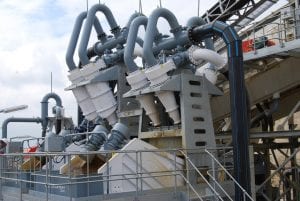Hydrocyclone systems is a static device that applies centrifugal force to a liquid mixture so as to promote the separation of heavy and light components. In Hydrocyclones, also known as liquid cyclones, the principle employed is centrifugal sedimentation, i.e., the particles in the suspension are subjected to centrifugal forces, which cause their separation from the fluid.
Hydrocyclones do not have moving parts, require a low installation and maintenance investment and are simple to operate. Hence, these devices are widely utilized in mineral, chemical, petrochemical, textile and metallurgical industries.
The hydrocyclone is a closed vessel designed to convert incoming liquid velocity into rotary motion. It does this by directing inflow tangentially near the top of a vertical cylinder. This spins the entire contents of the cylinder, creating centrifugal force in the liquid. Heavy components move outward toward the wall of the cylinder where they agglomerate and spiral down the wall to the outlet at the bottom of the vessel.
Hydrocyclone System

Light components move toward the axis of the hydrocyclone where they move up toward the outlet at the top of the vessel. The hydrocyclone separates solid and liquid or liquid and liquid by the difference in density between the fluid and the material to be separated in this equipment. The spiralling motion of the fluid caused by the tangent feeding, the material of larger density is thrown against the wall of the hydrocyclone and dragged to the underflow while the one of smaller density proceeds for the overflow, forming a free vortex (outer vortex) and a forced vortex (inner vortex).
Hydrocyclones are also related to centrifuges in that both are intended to separate heavies and lights by application of centrifugal force to liquids. The key difference is that hydrocyclones are passive separator packages capable of applying modest amounts of centrifugal force, whereas centrifuges are dynamic separators that are generally able to apply much more centrifugal force than hydrocyclones.
Another key difference between hydrocyclones and centrifuges is cost. Centrifuges are expensive precision rotating machines that often need sophisticated control, whereas hydrocyclones have no moving parts and have virtually no controls at all.
Hydrocyclones and centrifuges are complementary rather than competing devices. If gravity alone will settle a significant portion of your solids in a minute or two using a quick bottle test, you should investigate hydrocyclone separation. If settling takes much longer than this, then you may need a centrifuge or other separation method
A hydrocyclone is most often used to separate “heavies” from a liquid mixture originating at a centrifugal pump or some other continuous source of pressurized liquid. A hydrocyclone is most likely to be the right choice for processes where “lights” are the greater part of the mixture and where the “heavies” settle fairly easily.
Generally, hydrocyclones are used in continuous flow systems so that the instantaneous liquid inflow to the hydrocyclone is equal to the total instantaneous outflow of light particles plus heavy particles. In cases where heavy particles form very small part of the whole liquid, it is sometimes advantageous to accumulate them in the bottom of the hydrocyclone for batch wise removal.
In some applications, hydrocyclones capable of sharp separations of heavy particles & light particles are required. In other situations, they are used for incremental enrichment, reducing the load on other, more costly separation equipment and improving the overall economics of operation.
Hydrocyclones are generally not recommended for removing long fibres from liquids.
The separation efficiency of a hydrocyclone under a particular set of running conditions can be described in terms of the heavy particles concentration in the light particles outflow as a percentage of the heavy particles loading in the total inflow.
For example:
Heavy Particles loading in inflow = 5 %
Heavy Particles loading in Light Particles outflow = 0.5%
Separation efficiency = 100% x (5 -0.5) / 5 = 90 %
Changes in hydrocyclone operating conditions can lead to significant changes in separation efficiency. Some of the running conditions that can affect separation efficiency are:
- Inflow “heavies” concentration
- Inflow rate
- Outflow ratio (“heavies” flow vs “lights” flow)
- Temperature
- Viscosity
- Other bulk liquid characteristics
Generally two valves are installed on the hydrocyclone – one valve on the upflow outlet and the other on the downflow outlet in Pilot trials when settling characteristics are not known fully. This allows adjustment of the two flows during the trial. Once the optimum flow split is determined, valves can be substituted by orifices in routine service. Fixed orifices ensure that flow conditions do not change easily.

